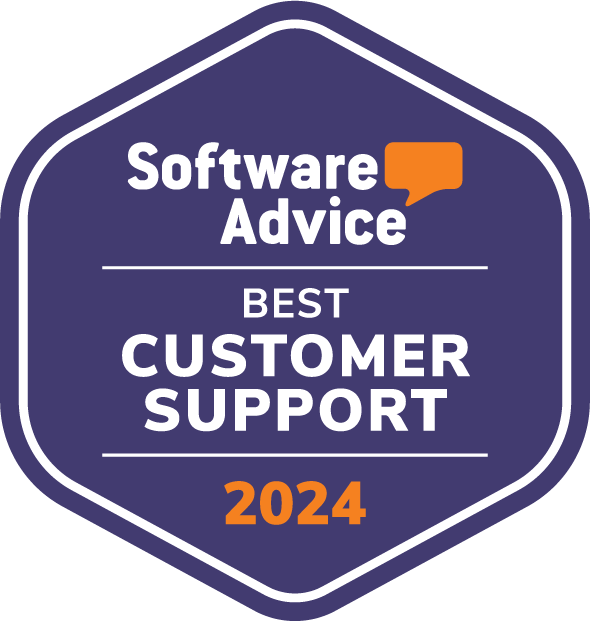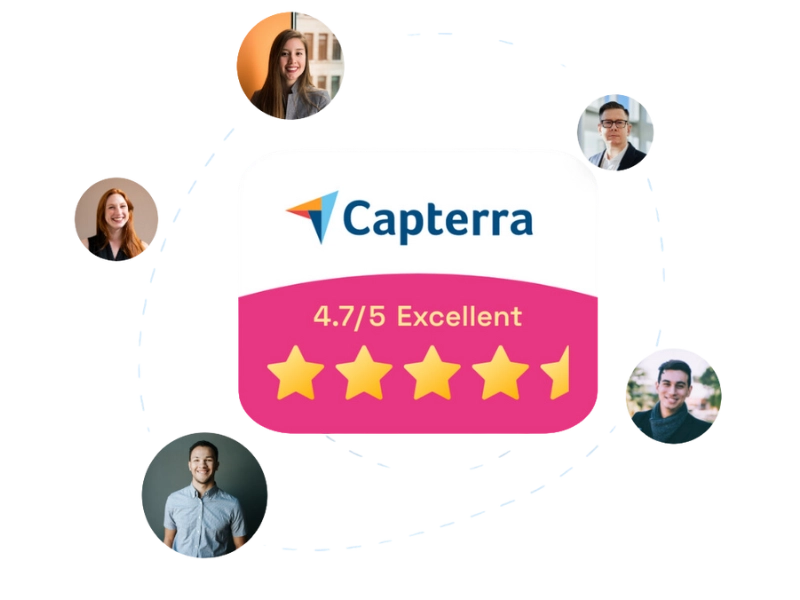Employee Experience Platform: Purpose and Best Pick
Once associated mainly with soft skills, the employee experience has become a measurable asset that affects the growth of internal know-how, the identity of a brand, and the ability to grow sustainably.
Especially after the pandemic, it became clear that engagement, training, and internal communication can no longer operate in silos. People experience the company as a single ecosystem, where each interaction should feel consistent and meaningful.
This understanding led to the emergence of a new solution that combines the need for innovation with the desire to feel part of a community as well as a business. This solution is known as "employee experience platform."
In this article, we will explore the key features of a platform dedicated to employee experience, why a company should invest in adopting one, and which solutions are available (and why the best is the intranet built on SharePoint Online).

Employee Experience Platform: Why talk about it?
When the pandemic turned the meeting room into a grid of faces on Microsoft Teams, many HR managers realized that the old tools were no longer enough.
It was not just about remote onboarding. It meant rethinking the entire way people experience work. From that moment on, "employee experience" stopped being an abstract concept reserved for consulting firm glossaries. It established itself as a strategic asset that integrates internal communication, process optimization, and productivity tools, with the goal of improving the overall experience in the digital workplace.
The employee experience has become a concrete metric that can be tracked in financial reports.
An employee who receives regular feedback, finds the latest policy in three clicks, and sees their contributions publicly recognized generally creates more value, stays longer at the company, and manages customer relationships more effectively. As a result, clients feel more satisfied.
In short, employee experience directly impacts the brand advocacy rate and the innovation rate of teams. That is why forward-thinking companies treat motivation and engagement as variables that, when measured in real time, allow them to adjust their growth strategies as quickly as the finance team updates a cash flow forecast.
This is where choosing the right platform becomes essential.
Without a central hub, data ends up scattered across Excel spreadsheets, anonymous surveys, informal chats, and various apps, each with its own isolated database. The result is the so-called "empty chair syndrome": delayed performance reviews, job applications lost in the approval process, and managers who cannot spot red flags before a talented employee decides to leave.
Hybrid work further increases the need for coordination.
In the office, engagement grew naturally from physical proximity. Colleagues exchanged ideas by the coffee machine, and managers could spot dissatisfaction by a gloomy look in the hallway.
Now that teams are more distributed, the company needs to replace those micro-moments with well-orchestrated digital interactions, without blocking spontaneity.
There needs to be a virtual space where people can share a client success, ask for feedback on a prototype from other departments, or simply celebrate a work anniversary with the entire organization, without constantly jumping between different apps.
When this digital environment is built on a productivity suite like Microsoft 365, the quality level increases significantly. Recognition shared in chat appears in performance profiles, completed courses update skill badges, and climate surveys generate actionable insights for managers, just to name a few examples.
The Great Resignation also made it clear that salary is not the only lever for attracting and retaining talent. Young professionals tend to favor companies that:
- offer a structured growth path;
- guarantee a balance between work and personal life;
- communicate authentically and back it up with action.
An employee experience platform makes all this tangible.
During the onboarding journey, for example, a new hire can receive a personalized roadmap that combines training modules, meetings with a mentor, and small measurable goals.
Each milestone unlocks new content, using a game-like progression logic.
This way, the new employee immediately feels they have a clear role and do not have to figure everything out on their own. This reduces the 20 percent drop in productivity that, according to numerous studies, occurs in the first six months when information is either implicit or hard to find.

Equally important is the topic of internal communication.
Newsletters and physical bulletin boards worked when messages were few and straightforward. Today’s fast-paced market requires constant but targeted updates to avoid overwhelming people with irrelevant information and dulling their attention.
Modern platforms use profiling to deliver news to the right recipients, just like social feeds segment content.
Another key aspect is measurability. Without a platform, HR teams typically gather feedback once or twice a year, often learning about internal issues only months after they arise.
With a regular survey system in place, the company’s overall sentiment remains visible at all times. But there is more. The best employee experience platforms, with the intranet standing out among them, allow for the integration of engagement data with operational metrics.
If a department starts participating less in internal initiatives, it could indicate that something is wrong. This may soon translate into more help desk tickets, more process errors, and increased stress.
Lastly, there is the matter of employer branding.
A platform open to external communities (such as innovation contests or university hackathons) provides an important public showcase for the company. In a labor market where reputation carries as much weight as compensation, having a dedicated space for brand and stakeholder relations is a highly valuable competitive advantage.
These are the reasons why we talk about employee experience and the platforms that help manage it effectively.
Because what is at stake goes beyond individual satisfaction. It has a profound impact on an organization's ability to grow despite the ongoing changes we see in the market (not to mention the world), and therefore, on its long-term competitiveness.
The 4 pillars of employee experience (and how to implement them)
Today, those who lead people in the workplace are expected to turn every stage of the employee journey into a moment of value, both for the individual and for the organization. Four closely connected elements contribute to achieving this goal:
- Continuous onboarding
- Engagement
- Recognition
- Communication
When these four pillars are taken seriously, they begin to overlap and reinforce one another, creating a virtuous cycle that improves individual well-being and strengthens company culture.
Continuous onboarding supports inclusion and development, which fuels engagement. An engaged employee is more motivated to contribute, especially when they receive genuine recognition. Communication ties everything together by making it visible, valued, and shared across the organization.
Let’s take a closer look at these four pillars.
1. Continuous onboarding
In the traditional onboarding model, the process ends when the new hire receives their badge, tours the office, and attends a first meeting with their manager. Today, such a short path is a luxury that no company can afford.
Talking about "continuous onboarding" means going beyond the idea of a formal welcome and instead guiding each new hire through a journey that starts with accepting the job offer and continues for at least the first six months of employment.
Platforms designed for employee experience activate a personalized digital channel even before the employee officially joins the company. This way, the new colleague:
- receives temporary login credentials;
- accesses content and services tailored to their role and needs;
- receives all required documentation to complete and sign electronically;
- can explore materials that explain the company’s values, mission, and goals;
- can complete mandatory training courses even before stepping into the office.
The result? The new hire is ready to work from day one, rather than being lost in bureaucracy, service communications, and waiting for answers to basic questions.
In addition, data collected by a platform like the intranet makes it possible to track how long it takes each new hire to become independent and identify the obstacles that slow their progress.

2. Personal growth
Adopting an employee engagement platform means equipping your organization with a digital ecosystem that integrates quick surveys, sentiment analysis, development paths, and ongoing feedback. It is about keeping an eye on the level of motivation and taking action quickly, before signs of discomfort turn into real problems.
The core of the system is not just the dashboard, but the breadth of signals it can process: productivity data, open-ended survey responses, participation rates in training programs, and engagement levels on internal channels.
All of this contributes to a vitality index that is easy to interpret even for frontline managers, helping them move away from one-off initiatives (such as the occasional motivational content) toward actions that address their team’s actual needs.
Let’s look at an example.
A manager sees, through the platform, a steady decline in team interaction with training content focused on soft skills. At the same time, an internal survey reveals open comments expressing frustration over the lack of growth opportunities.
Instead of offering the usual generic coaching, the manager can use these signals to create a personalized development path while also opening a space for dialogue to collect more feedback. With the intranet.ai solution, they could:
- set up a dedicated area for team training;
- create tailored courses using Microlearning, based on skills gaps and shared interests;
- use the Engagement Board to collect ideas and better understand how to support the team;
- regularly publish quick surveys to monitor motivation and satisfaction with the actions taken.
Within just a few weeks, participation increases, sentiment improves, and the team gains a clearer perception of the growth opportunities the company offers. The platform not only identified a critical issue but also delivered the insights and tools needed to build a people-centered response.
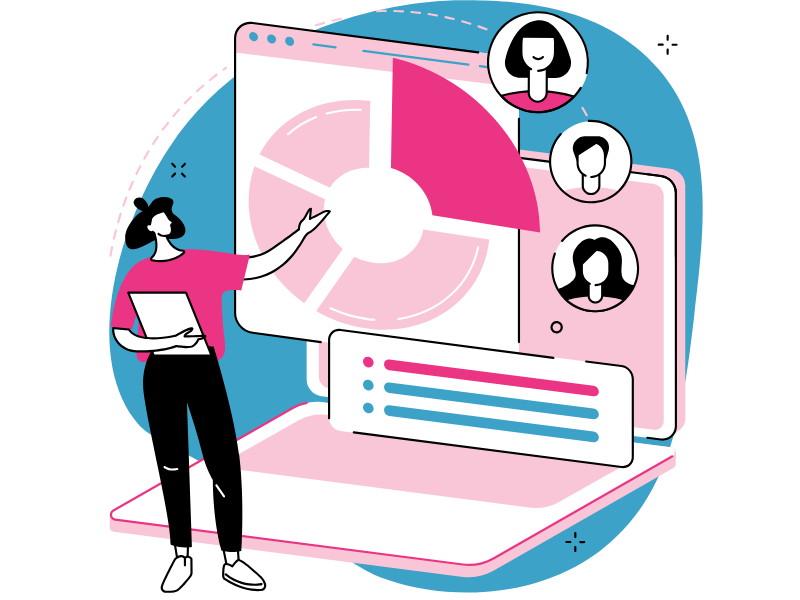
3. Recognition
Recognizing achievements goes beyond handing out an award at the end of the year.
A platform that focuses on valuing people offers dedicated spaces and features for the public recognition of individual contributions. These include:
- A digital success board, where team or individual accomplishments can be shared, whether small or large in scale;
- A gratitude points system, allowing users to express mutual appreciation in a structured way, with the option to convert points into personalized benefits or experiences;
- Symbolic badges, linked to measurable goals and the company’s core values, to strengthen the sense of belonging and encourage behaviors aligned with the internal culture.
To evaluate whether the system is working, it is important to cross-reference engagement data (survey response rates, interaction with internal communications, number of badges earned, and so on) with productivity trends, reduced turnover, and the volume of reports or alerts received.
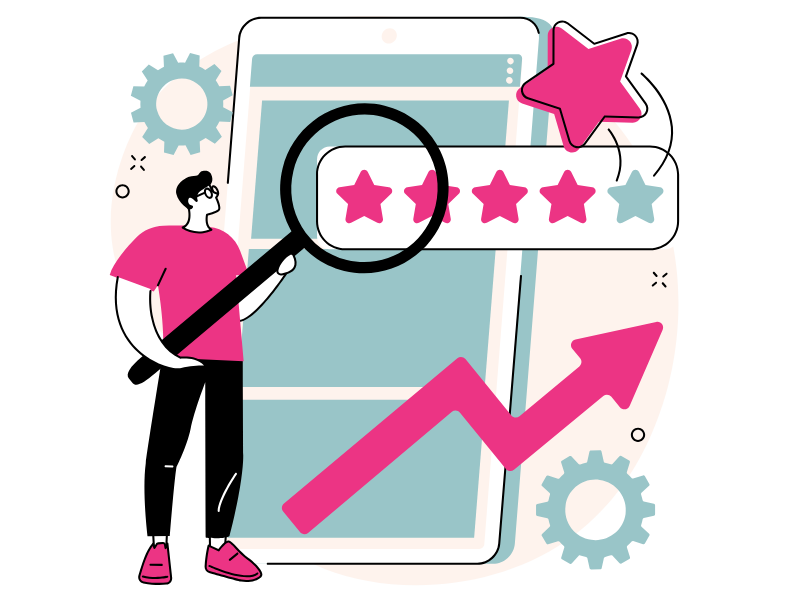
4. Communication
The fourth point is the most important, because without good internal communication, the other three cannot truly work.
The hybrid company (spread across office, home, train, and coworking spaces) needs a single gravitational center that clearly and consistently brings together news, documents, resources, and interactions that make up the digital workplace.
How can an employee experience platform help?
A modern system like an intranet based on SharePoint Online centralizes communication flows, eliminating fragmentation and redundancy. Here, every piece of information has its place, every voice finds a channel, and every contribution can be highlighted when it brings value to the organization.
This means giving consistency and visibility to communications, regardless of the location, device, or role of the person accessing them.
In this way, internal communication becomes a structural part of engagement; not just a top-down flow of information, but a two-way network built on exchange, listening, and sharing.
On a technical level, an effective platform supports:
- segmentation of communications based on roles, locations, or interests;
- multi-channel delivery (notifications, banners, mobile, email);
- integration with collaboration and knowledge-sharing tools;
- measurement of views and interactions.
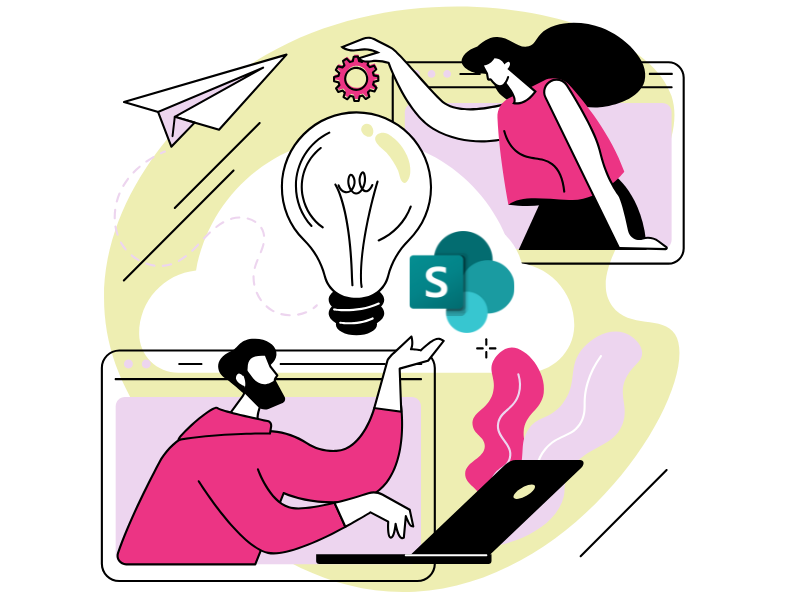
Comparing the top platforms for employee experience
Among the solutions that support employees throughout the entire company lifecycle (from application to potential offboarding) several platforms dedicated to employee experience stand out.
These platforms vary significantly in their features, each with its own strengths and limitations.
We briefly present them below.
Workvivo: social intranet with a focus on sentiment
Workvivo was designed to turn the corporate home page into a Facebook-style feed, where top-down announcements and spontaneous posts coexist. Its main strength is the speed with which communication becomes two-way. This is largely due to the short adoption curve, as the interaction model feels familiar.
However, when a company needs more controlled processes (for example, a multi-level workflow for policies or a document archive with versioning), external integrations or customizations become necessary, which increases the total cost of ownership.
In addition, the analytics remain focused on engagement and provide fewer operational insights into productivity or skills.
That said, since its acquisition by Zoom, the platform has expanded its analytics capabilities, as well as its artificial intelligence features for measuring overall company engagement.
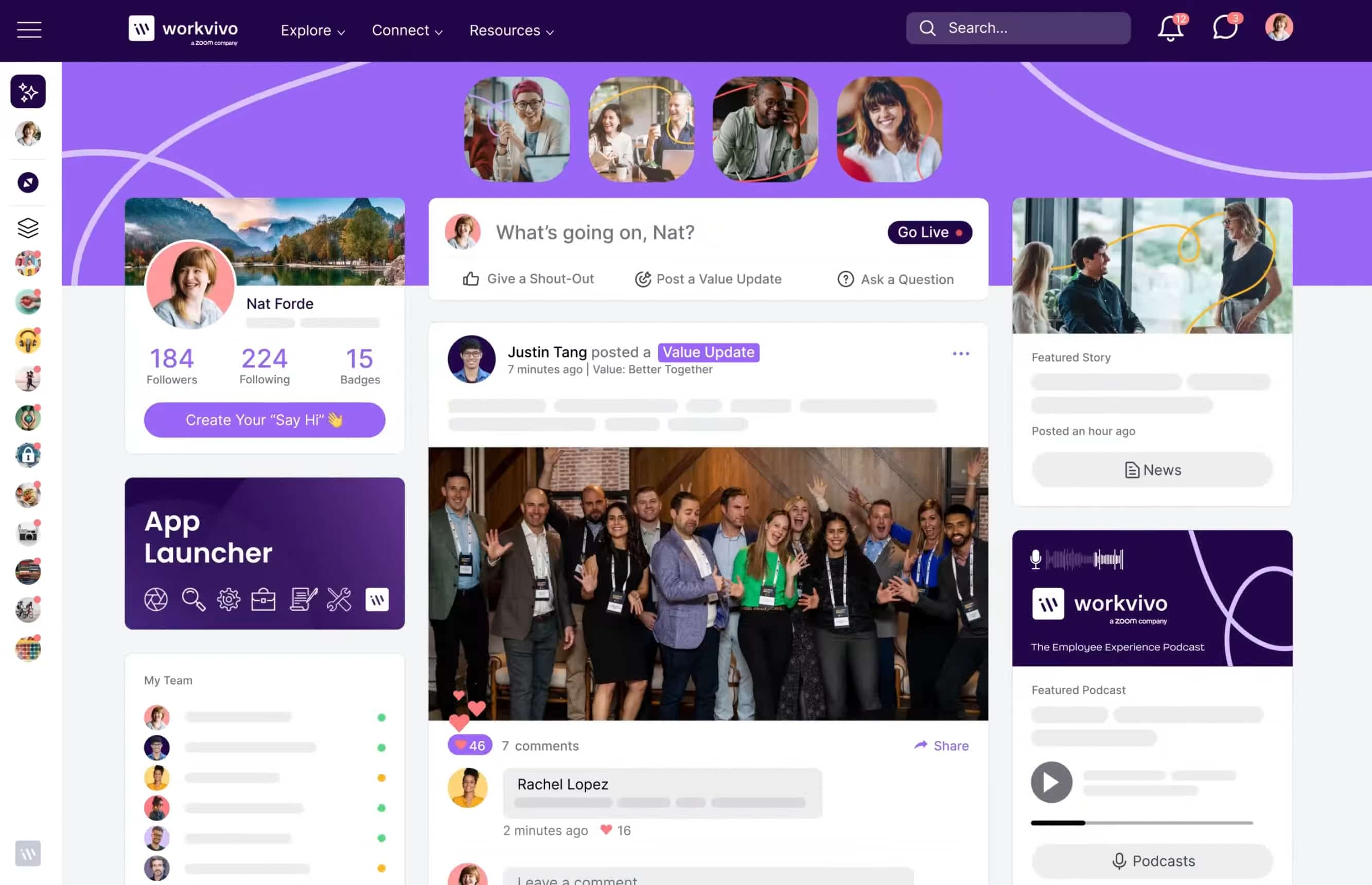
Overview of Workvivo
Bonusly: micro-recognition structure
Bonusly stands out for its lightweight peer-to-peer mechanism, which mainly involves monthly credits distributed among colleagues that can be converted into gift cards. The system works well where a culture of quick feedback is already in place, but it also reveals two hidden limitations.
First, the virtual currency needs to be backed by real budget, becoming a recurring cost that is difficult to reduce. Second, the scope is well defined (tactical recognition), but the platform does not manage development goals or sentiment tracking.
Additional modules are therefore needed to cover all areas of the employee experience.
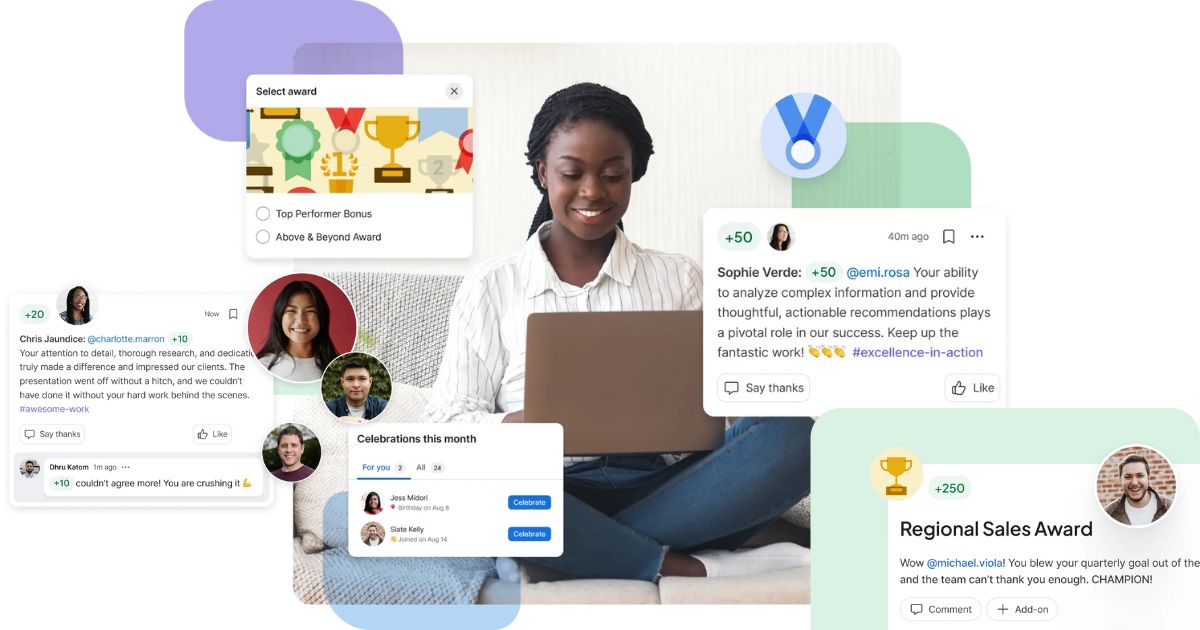
Overview of Bonusly
Motivosity: recognition with analytical ambitions
Unlike Bonusly, Motivosity attempts to integrate morale surveys and managerial check-ins.
The advantage it offers is the reduction in the number of employee engagement tools that need to be integrated into the digital workplace. Recently, with the "Lead" and "Listen" modules, the platform's additional features have become much more robust compared to the past.
In terms of TCO (total cost of ownership), the license price increases with the number of modules (Connect, Recognize, Lead, Listen), and the RTB (Return to Budget) should be calculated based on how much time managers will actually spend using the coaching modules.
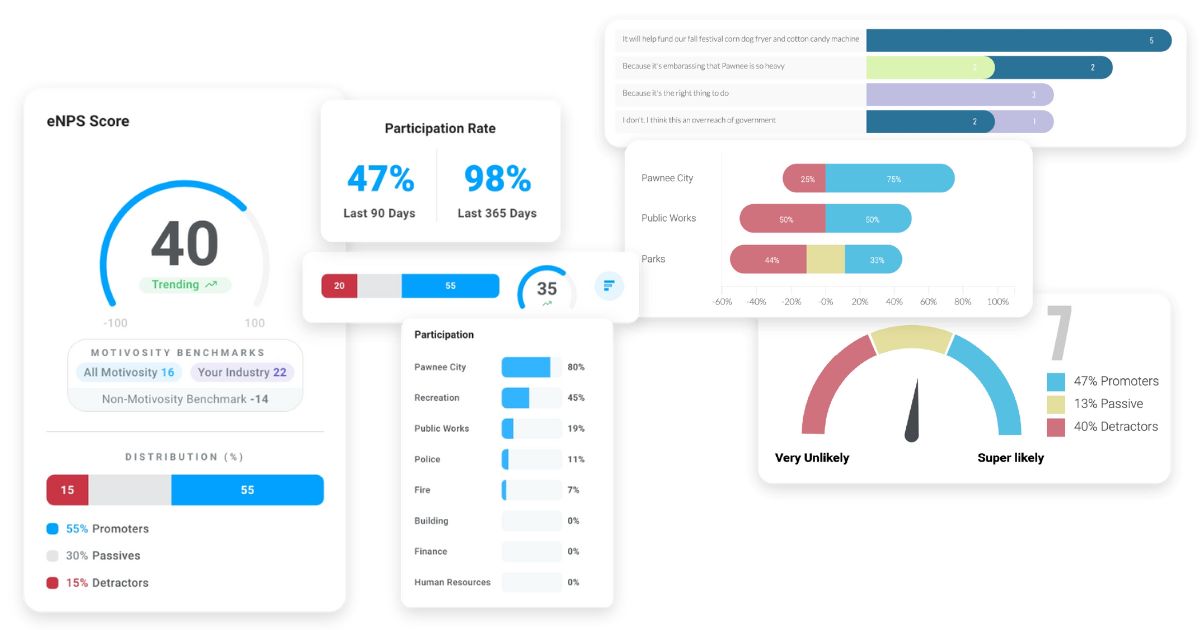
Breakdown of the metrics provided by Motivosity
Qualtrics: an experience rooted in data analysis
Qualtrics is based on an approach that aims to collect data at every touchpoint of the experience, then normalize it and present it through dynamic dashboards.
For an HR team with strong analytical maturity, this is definitely an advantage. From the welcome survey to the quarterly pulse check, everything flows into the same data lake. Additionally, the artificial intelligence features are designed to enhance the employee experience.
However, managing the platform requires statistical and modeling skills. Without a dedicated team, there is a risk of reducing Qualtrics to a basic survey tool, while still paying for an enterprise subscription.
Although in recent times Qualtrics has released several native connectors for HR, CRM, and workflow platforms, which means integration now requires less custom development than before, in advanced environments it still remains rather complex.
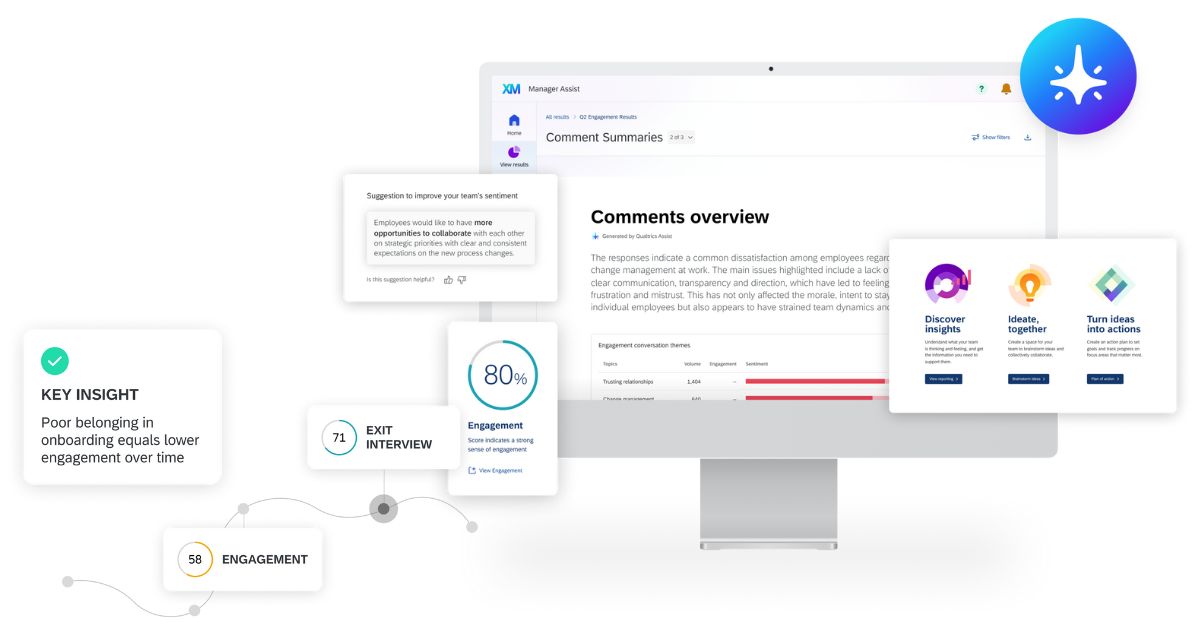
Overview of Qualtrics
Leapsome: a performance-oriented suite
Leapsome combines objectives, 360° reviews, growth plans, and engagement surveys.
Its key strength is the structural alignment between company objectives (OKRs), feedback, and learning paths. The system effectively builds clear bridges between performance and organizational growth.
The downside is the complex configuration required before the platform is fully operational, including the definition of competency frameworks, calibration of evaluation scales, and role mapping.
Those starting without mature processes risk a long and costly scoping phase.
From a financial perspective, the per-active-user license can be cost-effective for small and medium businesses, but it becomes burdensome in organizations with high seasonality (such as Retail and Hospitality, for example), where thousands of workers cycle in and out within a few months.

Overview of Leapsome
15Five: the "weekly check-in" philosophy
15Five revolves around the ritual of a short questionnaire, to be completed each week and discussed during one-on-one meetings. In this case, the advantage lies in the regularity, which helps turn feedback exchange into a habit.
The platform also offers additional modules for goal setting, semiannual reviews, and training (although the main pillar remains the survey).
The downside is that if management does not have time to read hundreds of weekly reports, the promise of visibility can quickly turn into a clear case of information overload. As for costs, the "Focus" plan may seem competitive, but to cover the full employee lifecycle (including growth and performance management), companies often need to upgrade to higher-tier plans rather quickly, especially to access advanced analytics and features for large-scale talent management.
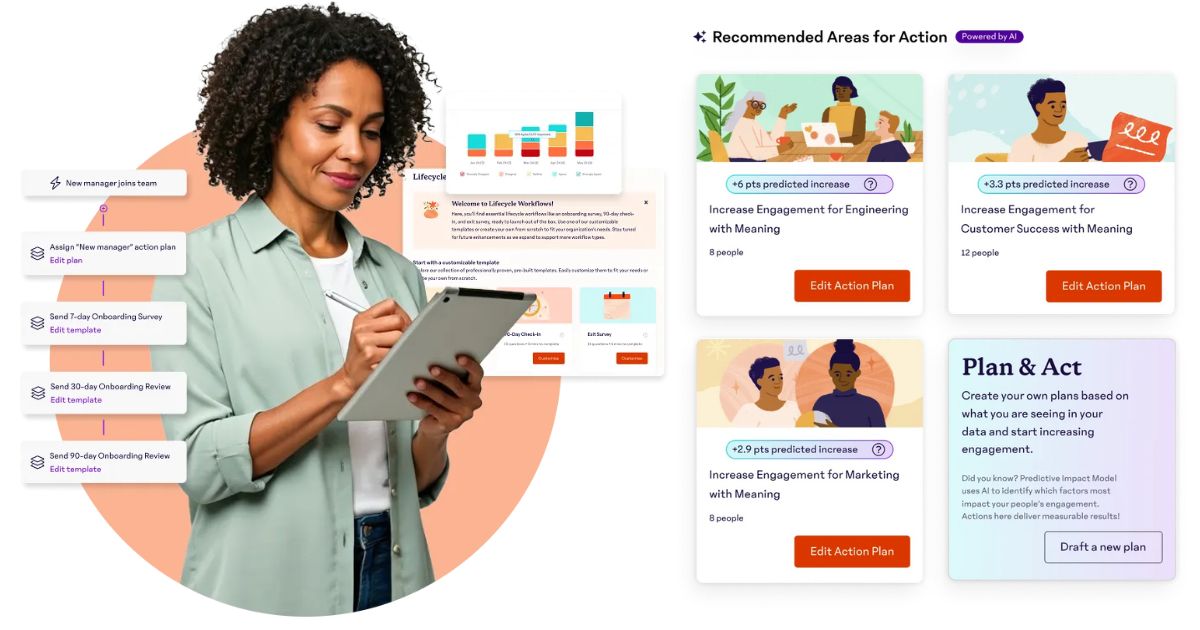
Overview of 15Five
Employee Experience Platform: Which one to choose?
From our brief analysis, no clear winner emerges.
However, there is a common denominator.
Although the ones presented are among the most popular platforms, none of them is complete.
Taken individually, these solutions are not capable of fully covering all stages of the employee journey. If the goal is to support people from application to exit interview, adopting any one of the platforms listed above may quickly turn into an integration puzzle.
The real question, then, is not "Which platform has feature X?" but rather "How much time and complexity does it take to truly integrate all the necessary functionalities to manage the employee experience, building a single trajectory of data, processes, and storytelling?"
The answer to this dilemma is simpler than we think.
An intranet built on SharePoint Online is the foundation for building your digital workplace using Microsoft 365 technology. In this ecosystem, all business processes, including the employee experience, integrate without complexity.
Thanks to the native connection that defines Microsoft applications, there is no need to stack solution upon solution or try to hold isolated tools together in a senseless technological patchwork. Everything is already designed to work together.
We will explore this further in the next section.
Employee Experience Platform: Why choose the SharePoint intranet?
An employee experience platform does not exist in a vacuum. It must interface with:
- the repositories where company documents are stored;
- the approval workflows that manage vacations and business trips;
- the communication channels used by on-site and remote colleagues.
In other words, it needs a backbone capable of holding together the essential components required to manage the employee experience in a comprehensive way.
And this is where we begin to talk about an intranet based on SharePoint Online.
Natively integrated with the Microsoft 365 ecosystem, the SharePoint intranet has a structural advantage that is unmatched compared to the vertical solutions mentioned earlier.
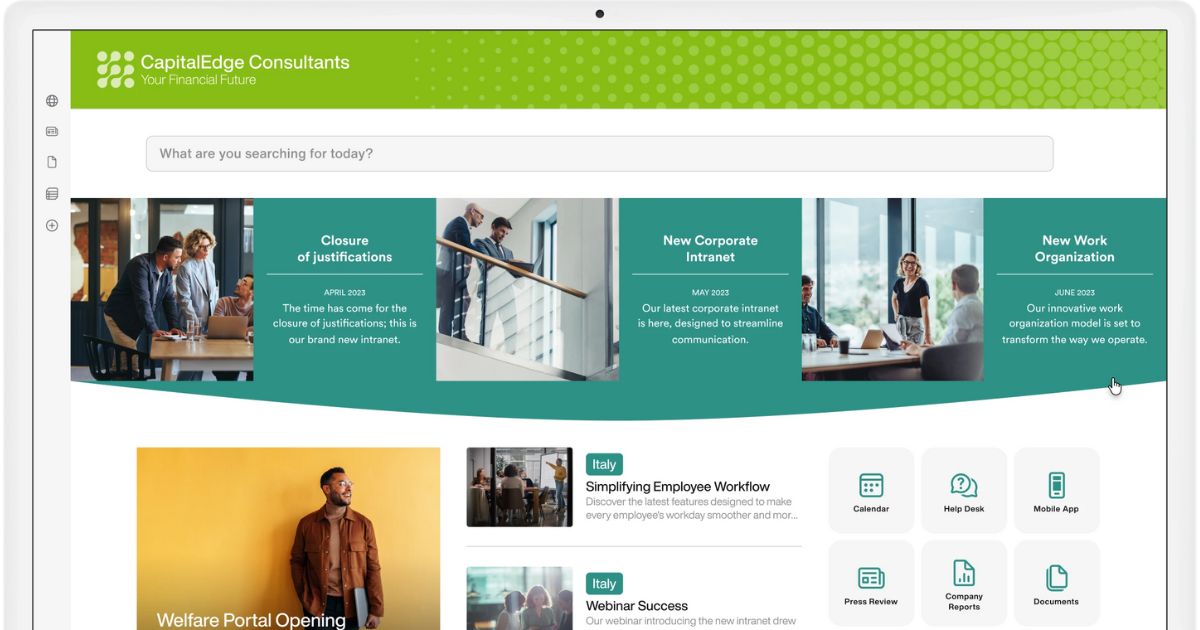
SharePoint intranet built with intranet.ai
The starting point is document management, the very purpose for which SharePoint was created.
The system does more than just host files. It stores versions, tracks who made changes, prevents simultaneous editing when an approval workflow is in place, and applies sensitivity labels that determine whether a document can leave the company or be copied to external devices.
All of this happens without third-party plugins, because the Microsoft 365 engine itself handles data encryption both in transit and at rest, geo-redundant backups, and compliance with major international regulations.
This document infrastructure is not an isolated system. When a file moves from draft to ready for publication, a Power Automate flow (created with a drag-and-drop interface, without any code) can be integrated to notify the reviewer, collect an electronic signature, publish the content on Teams, and if needed, trigger a push notification on Viva Engage.
The document-process-communication path stays entirely within the Microsoft environment, avoiding the app switching that often plagues vertical platforms.
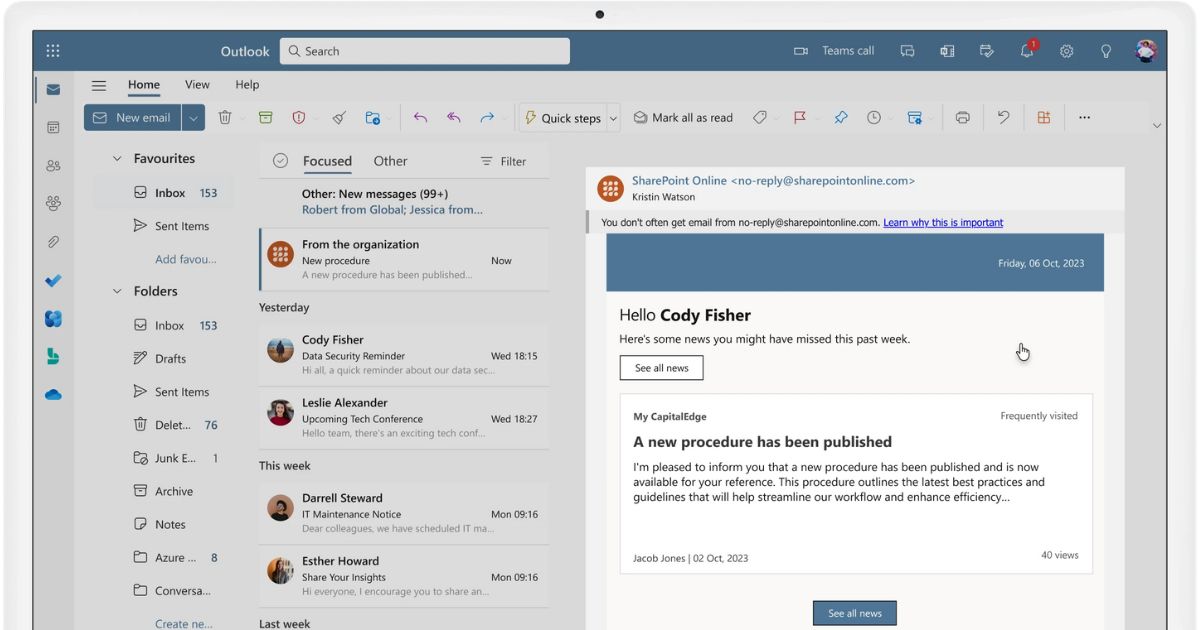
Automatic distribution of documents published on the intranet.ai SharePoint intranet
Administrative workflows are another key area.
With SharePoint, it is possible to design web forms (again, without using code) to register vacation requests, expense reports, or the onboarding steps of a new hire.
Each form then stores responses in a SharePoint list, which in turn can update the corresponding record in real time in Dataverse (the cloud database behind the Power Platform) or in an HRIS (Human Resources Information System) connected via API.
If we imagine the onboarding process in this way, here is what can happen:
- The recruiter pre-fills the new hire's information in a SharePoint list.
- A flow automatically generates an account in Microsoft Entra ID, assigns the appropriate 365 licenses, and creates the company email address.
- A second flow populates the manager's To Do list with welcome tasks, sends the new user an introductory course on Viva Learning, and grants welcome credits in the gamification module.
Regarding that last point, one of the most common limitations found in vertical employee experience platforms is gamification, which often comes as a closed box.
Points, badges, and leaderboards are locked inside a proprietary module and are difficult to extract for advanced analysis.
In a SharePoint intranet, on the other hand, the reward logic can be made transparent by creating calculated columns in lists or by assembling point systems using Power Automate. You can also integrate Microsoft Graph and Power Apps to create a custom dashboard.
In practice, all onboarding activities that generate points (completing a course, participating in a survey, sharing an idea on Viva Engage) are already part of Microsoft 365, so data tracking is immediate.
Every click made within the Microsoft suite is stored in unified logs that flow into Microsoft Purview and, if needed, into Azure Data Lake. Power BI reads these sources directly, allowing you to build reports without exporting .CSV from one application, .XML from another, and JSON from yet another. This kind of manual extraction becomes inevitable with vertical products when you want to build cross-functional views.
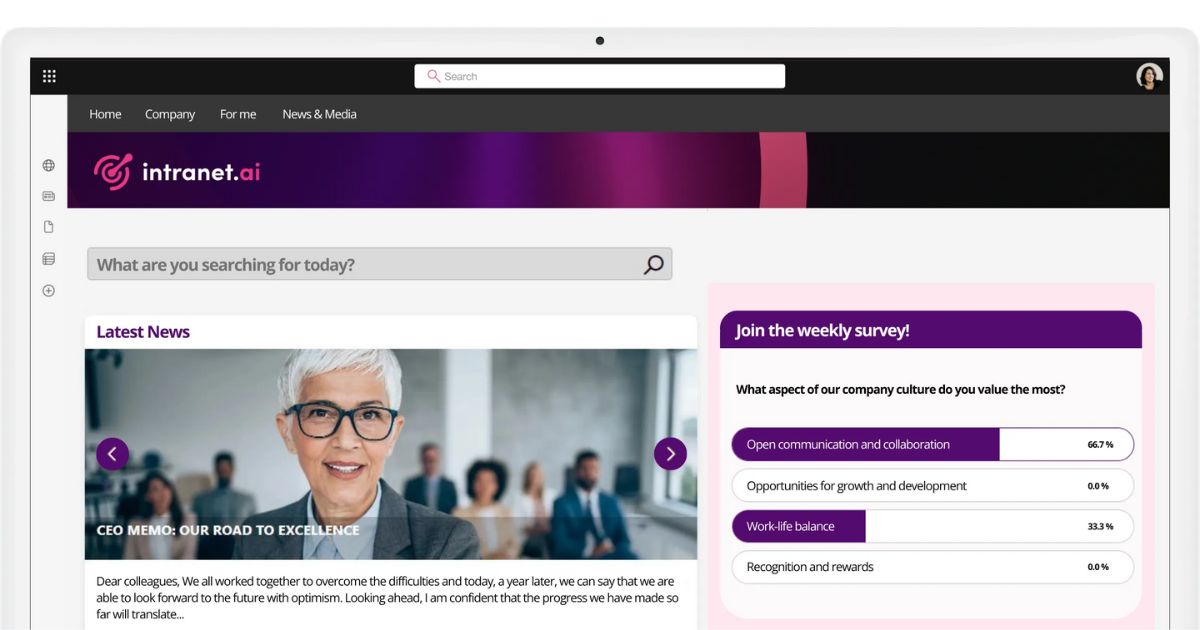
Collecting and analyzing data with intranet.ai quick surveys
Many vertical solutions for the employee experience claim to offer built-in security, but their control is often limited to the scope of a single application. The result is a fragmentation of policies across email, file sharing, internal communication, recognition, and survey tools.
With SharePoint (and more broadly with Microsoft 365), security is defined centrally within the tenant, and the settings are consistently inherited by all corporate services and applications, ensuring comprehensive protection and unified governance.
| Microsoft security features | Description |
| Sensitivity label | Once applied to a document, the label follows the file even after downloading or sending via email. If the policy requires it, Outlook blocks forwarding to external recipients. This automatic protection is a highly appreciated feature among Microsoft users, as sensitive information is safeguarded without requiring any specific action. |
| Conditional access | The same rules that protect Teams also apply to the intranet, shared documents, and HR tools. For example, just one login attempt from an unauthorized country can block authentication across all services. This way, users can access the digital environment only under secure conditions, with a consistent and protected experience across every tool. |
| Central audit | All relevant actions, from reading a document to editing a personal record, are tracked in a single compliance interface, without the need to consult different systems. This approach always results in greater transparency in managing user data and activities related to their company experience. |
From security to scalability is just a short step.
Especially in small and medium-sized enterprises, one of the most frequent objections to adopting SharePoint was the perceived complexity of implementation. With the introduction of site templates and Viva Connections, this obstacle is now a thing of the past.
Today, any user can create an internal communication portal in just a few hours, using Teams as the integrated front end and OneDrive for offline synchronization, with a smooth experience even for those without technical skills.
As the company grows, the same foundation supports broader structures.
Hub sites for country portals, site collections dedicated to R&D or Finance, data retention policies tailored to different geographic areas with varying regulatory requirements... the progression takes place without changing the platform. As a result, there is no need to migrate data, retrain users, or reinvent backup processes.
It is also worth noting that many companies already use Microsoft 365 to manage email and schedule meetings. In this case, it is useful to remember that SharePoint Online is included.
The only effort required concerns the initial setup and, if advanced flows or custom apps are desired, possibly purchasing some premium licenses.
A negligible burden when you consider that every other alternative introduces:
- a fee per user;
- an additional charge for advanced data analysis;
- a cost for integration with the company directory;
- practically mandatory technical support when going beyond the basic features.
The difference between the SharePoint intranet and its competitors lies in the paradigm.
Not just another piece in the constellation of HR tools, but a complete platform, already present in the digital workplace, that makes it possible (and extremely easy) to orchestrate all the other applications needed to digitize and optimize internal processes.
This includes, as mentioned, the employee experience.
Do you want a complete, ready-to-use intranet?
intranet.ai is the SharePoint Online-based solution for simplifying internal communication and digitizing business processes with minimal investment of time and money.
- 50+ features for communication and employee experience
- Branded design, customizable in every detail
- Full integration with Microsoft 365 and Viva
Giuseppe Marchi
Microsoft MVP for SharePoint and Microsoft 365 since 2010.
Giuseppe is the founder of intranet.ai and one of the top experts in Italy for all things Microsoft 365. For years, he has been helping companies build their digital workspace on Microsoft's cloud, curating the people experience.
He organizes monthly online events to update customers on what's new in Microsoft 365 and help them get the most out of their digital workplace.

FAQ about employee experience platforms
What is an Employee Experience Platform (EEP)?
An Employee Experience Platform is a digital tool that helps companies improve the work experience of their people by integrating internal communication, training, recognition, and engagement into a single cohesive environment. After the pandemic, employee experience has become a measurable strategic asset capable of influencing productivity, retention, and brand identity.
Why should companies invest in an EEP?
Investing in an EEP means equipping the company with a digital infrastructure that allows real-time monitoring of employee motivation, strengthens the sense of belonging, and enables quicker intervention in case of internal issues. In an increasingly distributed work environment, replacing typical office-based informal interactions with orchestrated yet authentic digital moments is essential.
What are the key pillars of a good employee experience?
A good employee experience is based on continuous onboarding, personal growth, recognition, and communication. These elements reinforce one another: onboarding supports inclusion and autonomy, which in turn boost engagement; an engaged employee is more inclined to contribute actively, especially when their work is appreciated; finally, effective internal communication connects and gives visibility to the entire process, making the experience consistent and meaningful.
Why use SharePoint Online as a platform for employee experience?
A SharePoint Online-based intranet is already natively integrated with Microsoft 365, which makes it possible to orchestrate all activities related to employee experience without relying on external solutions or additional plugins. Document management, approval workflows, internal communication, badges, gamification, training, surveys, and data analysis coexist in a single secure, scalable, and centrally governed ecosystem.
What features should a modern EEP offer?
A modern platform must make every moment of the work journey tangible, starting from pre-onboarding, through personalized learning paths and public recognition mechanisms, up to the ability to collect frequent feedback and turn it into meaningful actions. It must also support segmented communication, centralized content, and provide simple tools to create workflows, gather data, and generate actionable insights.
How does a SharePoint intranet differ from other vertical solutions?
Vertical solutions tend to focus on a specific dimension of the experience but then require additional modules or tools to cover the entire employee lifecycle. This results in increased complexity, integration costs, and governance challenges. In contrast, a SharePoint intranet allows for smooth and seamless management of the entire employee experience thanks to the natural interoperability of Microsoft services.
How is the success of an Employee Experience Platform measured?
The success of an Employee Experience Platform is measured by its ability to generate relevant insights by cross-referencing different types of data, such as content engagement, survey results, participation in initiatives, productivity, and process trends. If a department participates less in company life or provides less feedback, the platform must be able to detect these trends and trigger corrective strategies promptly.
Can an EEP also enhance employer branding?
Yes, because it allows the creation of digital spaces that are also visible externally, such as communities, contests, or hackathons, which enhance the brand’s reputation as an employer. In a market where reputation weighs as much as compensation, having a well-designed showcase to highlight the company-employee relationship is a competitive advantage that few solutions can offer.
Keep on reading
SharePoint Intranet Tips, for Beginners and Experts



Our consultants' advice on how to design a good SharePoint intranet, manage it properly, and help it grow by engaging your colleagues.
Corporate training: How to manage it with Microsoft 365



From planning to tracking results, let's explore the techniques and tools to enhance the corporate training experience.
Digital Workplace Consulting: The Holistic Service by intranet.ai



A focused consultancy improves management, security, and UX within the digital workplace. Among the available services, here's why you should choose ours.
